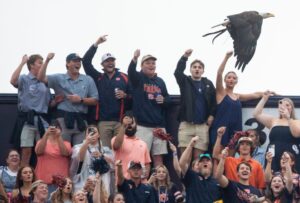Assessing WVU’s Portal Losses
Over the last several years, college football fans have had a love-hate relationship with the NCAA transfer portal. As part of the changing landscape of college football that now includes NIL compensation for players, the NCAA created the transfer portal to ease player movement several years ago. Indeed, it first impacted the 2018 college football season. West Virginia fans, unfortunately, feel like they deal with the worst of the portal. Sensationalist media sources claim that the portal is particularly bad to Mountaineer fans, and those fans point fingers at Head Coach Neal Brown as the problem. Contrary to some claims, however, West Virginia is not losing the most players to the portal. That said, as the losses continue to pile up, we thought it worthwhile to review. As a result, we are assessing WVU’s portal losses since its inception.
Establishing the Ground Rules
First, we note that we look to 247Sports for its superior collection of college football data. With a network that covers the whole of FBS football, they are far better suited to track each and every transfer. They collect names, presumably from the transfer portal itself, and organize that data into useful information. They have a portal tracker that groups transfers by conference, by the team, by transfer rating, and by year. That system defines a year not as a calendar year (because it doesn’t make sense). Instead, they define a year in terms of the portal to begin when the first FBS game is played and to end before the first FBS game is played in the next season.
Unfortunately, they do not yet track transfers by the school according to inbound versus outbound transfers. As a result, each grouping by school and year includes both inbound and outbound transfers to and from that school. Additionally, they include transfers who entered and withdrew from the portal. As a result, if a player enters the portal but remains at the same school, the player still shows up. Additionally, players that enter the portal but ultimately declare for the draft instead are included in their numbers. In our numbers, we excluded those two categories. As it pertains to West Virginia, for example, we excluded Kenny Robinson as an outbound transfer because he declared for the NFL draft during the same offseason in which he entered the portal.
How We Use the Data
We do, however, group our data by year and use the same measure that 247 does. West Virginia, for example, has seen several inbound transfers after the first week of Fall Camp. We have also seen a few outbound transfers in the days leading up to the opening kickoff.
Once a season begins, the player counts towards the next class (because he cannot enroll in his new school and play in games until the next season). If a player transfers before the season begins, however, he counts for that same year (because he may still be eligible to enroll and play in that season).
Put more simply, the 2022 transfer class includes any player who entered the portal beginning in late August 2022. This class, obviously, is not yet complete. Players will transfer through Winter, Spring, and Summer. The 2021 class, on the other hand, is the most recent full transfer class. Nobody will be added to it or removed from it as the 2021 season is nearly complete (and the transfer class ended in late August).
The first year that 247Sports reliably tracked portal entries was the Class of 2019 (players transferring after the first game of 2018 and before the first game of 2019). We now have three full years of transfer data and one partial year (the Class of 2022). Thus, when we talk about total players in the transfer per school, we include players in the Classes of 2019 through 2022. When we talk about the average number of transfers per year, we only use the Classes of 2019 through 2021. Since the Class of 2022 is not yet complete, it does not make sense to use this year in averages. The data used in this article remains current as of December 9, 2021.
Assessing WVU’s Portal Losses: By the Numbers
Unfortunately, as we wrote last season, the transfer portal represents a large part of the “new normal” in Morgantown. The portal is part of the game, like it or not. West Virginia loses players to it each year. In 2019, WVU lost nine to the portal; in 2020, they lost 11; and, in 2021, they lost 21. So far, the Mountaineers feature 12 players currently in the portal.
Certainly, none like to see double-digit players in the portal each year. For a school like West Virginia that has typically relied on building depth over several years to make a big jump in standing every third year or so, the portal represents a phasing out of that strategy. That said, it is what it is at this point. Adapt or fade away, as they say.
In total, West Virginia has lost a total of 53 players through the portal over the last four seasons (including the current season). We certainly hope that this season’s entries slow to a crawl between now and the opening kickoff next year. That said, we certainly cannot predict the future whims of young adults. We can, however, say that is not the highest number of outbound transfers in that period, as Tennessee and Nebraska, for example, both lost 63 players to the portal in that same time frame.
Assessing WVU’s Portal Losses: By Quality
As much as losing depth hurts, West Virginia has fared relatively well in terms of the quality of players lost. In 2019, two of the nine outbound transfers came from the walk-on ranks. None of the players landed at Power Five schools. On the other hand, the Mountaineers gained five players from Power Five schools. Three of them–George Campbell, Reuben Jones, and Josh Growden–represented high-quality additions.
In 2020, one of the 11 outbound transfers was a walk-on. Two players (Josh Sills and Jovani Haskins) ended up at Power Five schools. Again, WVU gained five inbound transfers from Power Five programs. Two of them represented high-quality additions in Tony Fields and Scottie Young. Additionally, Ja’Quay Hubbard could prove valuable in the next two seasons.
2021 represented the worst year for the Mountaineers in the portal. Two full-time starters left for SEC schools (Dreshun Miller to Auburn and Tykee Smith to Georgia). One steady contributor (Jeffery Pooler) left for Vanderbilt. Two others left for Power Five schools (Alec Sinkfield to Boston College and Junior Uzebu to Vanderbilt). Only one of the 21 outbound transfers was a walk-on. The Mountaineers, on the flip side, gained Doug Nester and Lance Dixon.
So far this year, WVU surrendered twelve players to the portal. We do not yet know where they will land. Nonetheless, some players were surprised with their entry. T.J. Banks, Isaiah Esdale, and Sam Brown represent the most notable entrants.
Has WVU Lost the Most to the Portal?
Put simply: no, the Mountaineers have not lost more players to the portal than every other school in the country by any measure. These rumblings should be put to rest immediately. Indeed, when assessing WVU’s portal losses, we collected the data methodically. We were not sure what we would find. Perhaps those spreading the information were correct. Maybe they missed something.
We cannot be sure what they missed (or perhaps what we are missing), but the facts prove the assertions false. West Virginia, to be fair, continues to rack up Class of 2022 portal entrants. That said, they are not the team with the most outbound transfers so far in this class. Those honors belong to Syracuse and Indiana, both of whom have seen 15 players enter the portal so far. Even when we measured by calendar year (we did not do this for every team, but looked at teams with high numbers in both 2021 and 2022), Tennessee has lost more players to the portal in the 2021 calendar year than West Virginia.
As we mentioned earlier, however, we do not find it useful to measure by calendar year. Additionally, we do not find looking at the Class of 2022 as particularly representative either. Some teams that average double-digit transfers have lost very few so far this year. Michigan, for example, who lost an average of 16.7 players over the first three transfer portal years, has lost just two so far this year. That comes with good reason. They have an outside chance at winning a National Championship this year. Win or lose, though, we can fully expect them to add to their Class of 2022 totals.
Measuring WVU’s Portal Losses Against the Rest
Finally, in assessing WVU’s portal losses, we compared the Mountaineers’ numbers to the rest of the Power Five team plus Notre Dame and BYU. Among that group of teams (we will refer to them as the Power Five schools hereafter), the average team adds 10.9 players to the portal per year. Isolating only to Power Five schools, an incredible number (2,585 players) have transferred since the start of the 2018 season. Thus, the Mountaineers certainly are not the only team losing players to the portal.
WVU averaged 12.7 players lost to the portal in 2019 through 2021 transfer classes. That is not even the worst in the Big 12. Instead, Texas Tech (13) and Oklahoma (14) carry those honors. At this moment, WVU does have the most total players to have left through the portal in the conference (53), but Oklahoma (49), Kansas State (45), and Texas (42) are not far behind. Those schools could well eclipse the Mountaineers in total by the end of this transfer cycle.
Nationwide, there are 17 programs with more entrants into the portal using the three-year average. For example, Michigan averages nearly 17 per year. Nebraska and Tennessee lead the nation by averaging 19 portal entrants per year. By comparison, West Virginia’s numbers look relatively pedestrian.
Ultimately, we agree with Mountaineer fans that we hate seeing so much depth lost to the portal. It is not the game we grew up watching. That said, it is far beyond our ability to change that trend, which, as of now, continues to grow–for all schools. I doubt we can find much comfort in it, but West Virginia is not an outlier here. Indeed, more than a quarter of Power Five schools (even ones with more stable coaching staffs and better on-field results) lose just as much, if not more, to the portal yearly as WVU does.






